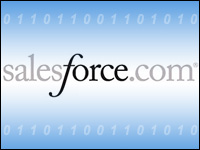
There is an interesting debate beginning to brew in the on-demand market. Although most people are still clearing their throats, sides have been chosen and trial balloons have been floated. It appears that a small group of big companies, including Oracle, SAP and Microsoft, are trying to slow Salesforce.com’s momentum by going after the crown jewel. Another way to say it is that these companies are trying to hop on board a moving train.
In one corner is Salesforce.com, the incumbent and still champion with its multi-tenant architecture. In the other corner are the challengers, singing a siren song about freedom of choice, offering various flavors of hosting ranging from multi-tenant to single-tenant, with a lot of wiggle room in the middle and a Cheney-esque “So?”
Of course, all this tenancy refers to the way the software is put together and made to work. Single-tenant means one computer (usually) and one copy of the software and all of a company’s users. In single-tenant, or single instance, each additional company has to buy its own software and a system to run it.
Multi-tenant is different; it means one or more computers, one copy of the software and as many users as you want — it’s all you can eat, and it doesn’t matter what company you’re from. Behind the scenes in multi-tenant architectures, there is a lot of sophisticated software that keeps things separate, but it’s all invisible to the user. The benefit to everyone is that one copy of the software means one copy to manage, maintain, improve, patch and generally take care of.
The Erosion of On-Premise
Not long ago, there wasn’t much choice — every application or package you could buy was single-tenant. It was client-server software, and it was expensive to buy and implement, but that’s the way it was. Then Salesforce.com came along and made several changes almost overnight. In addition to leading the charge in on-demand and multi-tenant, they achieved a new price point for business software that ran in a browser and just about killed the market for conventional business applications. That’s not to say that enterprises all jumped on the bandwagon, but there’s been a steady erosion in the on-premise market ever since. I can’t remember the last time a new software company raised its hand and said, “We’re going to make ours using the old recipe.”
That’s all ancient history. Fast forward to today and you see the challenge I alluded to. Companies are trying to sell single-tenant on-demand and they are saying that the architectural underpinnings don’t matter. To hear the other vendors tell the story, multi-tenant is snake oil and everyone ought to have a choice to go in whatever direction they like. That sounds pretty reasonable, but is it a valid proposition or just convenient marketing of single-tenant software?
For example, according to Anthony Lye, senior vice president of CRM at Oracle, “On-demand is just that, a service, a subscription, a delivery option to an application that provides business value to its users, we do that and do that well. We have chosen to provide our customers with choice.” By choice, Lye means using single- or multi-tenant as needed.
An Important Distinction
Lye makes a good point. Some companies are not willing or able to go with a multi-tenant approach. Some entities, like banks, have regulatory mandates to keep their data behind their firewalls, and I hear the European Union insists on keeping some types of data inside the EU. Nevertheless, providing a choice of single- or multi-tenant is not the same thing as saying that on-demand is just a delivery option.
I like Anthony Lye, and I think he’s one of the bright spots in the Oracle bureaucracy; however, I think Oracle and the others are trying to blur a distinction that really matters. In the years since Salesforce.com came on the scene, every software maker worth its compiler has been working hard to eliminate the biggest causes for customer angst. They’ve replaced client-server software with browser-based applications that put nothing on the client machine, and they’ve worked on making their applications less expensive and easier to use — all good things.
However, now the message seems to be if it’s low-cost and delivered in a browser across the Internet, it’s good enough. I believe that single-tenant, or even an application that can be distributed as either single- or multi-tenant, poses hidden problems. The biggest challenge I see is that single-tenant delivered on-demand is not simply another delivery option; it is a neat way of perpetuating a vendor’s hold on the customer, and it is facilities management by another name.
The Old FM Song
With single-tenant, all you’ve really done is to place a longer wire between the server and the client, and it reminds me of a very old approach called “facilities management” (FM). In FM, a vendor hosts your data center at another location and takes care of all the management for you. In this it sounds a lot like any other flavor of on-demand, but in the FM data center, rather than having a single copy of the software to manage, there are hundreds or even thousands of copies running on a similarly huge number of servers. The vendor achieves economy of scale, takes a profit and passes some of it on to the customer so that the cost per user these days can approach that of multi-tenant.
However, consider what that means. By choosing the single-tenant approach, you also choose a more limited number of applications that you can work with, and often that means locking into the vendor’s own portfolio. In contrast, the multi-tenant approach gives you no choice over which delivery mode you use, but the number and kind of third party applications is greater. In the Salesforce.com case, we all know that the AppExchange contains about 800 applications from third party developers, and all of them are pre-integrated.
So, in my mind, the debate really isn’t about giving customers a choice between single- and multi-tenant — that’s a false choice, like saying my way or the highway. The choice is really about giving customers a choice between vendor lock-down and the freedom to choose whatever applications make sense for their businesses. In my mind, single- vs. multi-tenant and the idea of choice are a big side show designed to deflect attention from the success of multi-tenant and save an empire’s worth of old code.
Denis Pombriant is the managing principal of the Beagle Research Group, a CRM market research firm and consultancy. Pombriant’s research concentrates on evolving product ideas and emerging companies in the sales, marketing and call center disciplines. His research is freely distributed through a blog and Web site. He is working on a book and can be reached at [email protected].























































